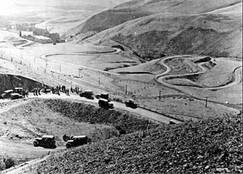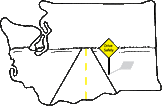|
Good roads are more than my hobby; they are my religion.
– Sam Hill Coming Events127th Annual Conference October 30, 2025 10:00 a.m. - 1:00 p.m. 22323 Pacific Hwy. S. Des Moines, WA 98198 Virtual Attendance Available Sam Hill Mansion Flying Tour of Seattle Tunnel |
Vision
A State of Washington where communities and resources are connected by a safe and effective
transportation system that maximizes benefits to the public and minimizes environmental impacts. MissionAs a member driven organization, WSGRTA advocates in public and private venues for policies and
projects that advance the organization’s Vision for good roads and transportation. Our History Maryhill Loops road, c. 1930.
In the late 1800s very few roads in Washington were more than dirt trails graded by farmers. There were no paved roads and no planned road or highway system. In 1898, a successful railroad executive arrived in Washington, having recently quit his job to pursue ventures that would be for the good of humankind. That man was Sam Hill and his message was clear. An organized system of quality roads was necessary for farmers and the overall economy. But many were skeptical of Mr. Hills motives and his campaign was slow to start. In 1899, he invited about 100 men that were in agreement with his cause to meet in Spokane to form a state organization promoting good roads building. Only 14 attended, but the Good Roads Association was founded.
After continually lobbying the legislature for several years, under suspicion of many prominent farmers and businessmen who believed the group's cause was a charade, the associations hard work began to pay off in 1905. The legislature created a highway department, and by 1907 the Good Roads Association had succeeded in getting the state to pay for a dozen state highways and half of the approved county road. In 1911, one of the founding principles of the association was voted in, declaring their support of a highway system to be built, maintained, and managed by the state, rather than the counties. TodayWhile we have come a long way since the late 1800s, we cannot stop the campaign for good roads. The Washington State Good Roads & Transportation Association continues to promote good roads and transportation in our state. The viability of our transportation system is important to every Washingtonian regardless of their occupation or political affiliation. Our membership is diverse and includes individual concerned citizens, cities and counties, contractors, engineering firms, labor organizations, transit, transportation organizations, WSDOT, and more. Each brings their view of the needs, successes, and failures within our state's transportation system. These views are shared, discussed, and a common message is delivered from WSGRTA to the key players involved in funding, constructing, and maintaining this system. Join the WSGRTA today to help make a difference!
Goals1) Establish system preservation and maintenance as a core state transportation priority and seek
adequate ongoing funding for that purpose.
required by the 18th amendment to the state constitution.
Definitions: - Good Road: A roadway that is accessible, safe, smooth, and treads lightly on the environment. - Accessible: As barrier-free as possible for all communities within available resources. - Safe: Meets minimum engineering and maintenance standards. Users and neighbors think it is “safe.” - Smooth: Meets minimum engineering and maintenance standards within available resources. - Treads Lightly on the Environment: Meets minimum environmental standards and promotes environmental enhancement. |
Links
|
